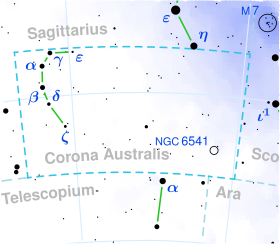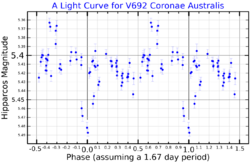Astronomy:V692 Coronae Australis
| Observation data Epoch J2000.0 Equinox (celestial coordinates) | |
|---|---|
| Constellation | Corona Australis |
| Right ascension | 18h 13m 12.69843s[1] |
| Declination | −41° 20′ 09.9972″[1] |
| Apparent magnitude (V) | 5.46[2] (5.46 - 5.51)[3] |
| Characteristics | |
| Spectral type | B2 III[4] or B1.5 IIIp[5] |
| B−V color index | −0.17[6] |
| Variable type | SX Arietis[7] |
| Astrometry | |
| Radial velocity (Rv) | −15.3±2.8[8] km/s |
| Proper motion (μ) | RA: −2.050[1] mas/yr Dec.: −6.210[1] mas/yr |
| Parallax (π) | 1.7423 ± 0.0977[1] mas |
| Distance | 1,900 ± 100 ly (570 ± 30 pc) |
| Absolute magnitude (MV) | −6.44[9] or −2.26[10] |
| Details | |
| Mass | 7.35±0.48[11] M☉ |
| Radius | 12.6±0.7[12] R☉ |
| Luminosity (bolometric) | 4,181[11] L☉ |
| Surface gravity (log g) | 3.52+0.33−0.14[1] cgs |
| Temperature | 17,061+1,474−1,357[13] K |
| Rotational velocity (v sin i) | 212±9[14] km/s |
| Age | 31.6±5.1[15] Myr |
| Other designations | |
| Database references | |
| SIMBAD | data |
V692 Coronae Australis (HD 166596; HR 6804; 3 G. CrA), or simply V692 CrA, is a whitish-blue hued variable star located in the southern constellation Corona Australis. It has a maximum apparent magnitude of 5.46,[2] making it faintly visible to the naked eye. The object is located relatively far at a distance of approximately 1,900 light years based on Gaia DR3 parallax measurements,[1] but it is approaching the Solar System with a fairly constrained heliocentric radial velocity of −15.3 km/s.[8] At its current distance, V692 CrA's brightness is heavily diminished by 0.46 magnitudes due to extinction due to interstellar dust.[17] Its absolute magnitude depends on the source: Westin (1985) gave a value of −6.44[9] while the extended Hipparcos catalogue gave a value of −2.26.[10]
Astronomers Carlos and Mercedes Jaschek along with a colleague listed HD 166596 as a Be star in 1964.[19] However, its status as an Ap star was not observed until 1979 by astronomers N. Vogt and A.M Faundez.[20] A year later, HD 166596 was observed to be variable and it had a period of 1.67 days.[21] In 1981, its variability was confirmed and it was given the variable star designation V692 Coronae Australis—the 692nd variable star in Corona Australis.[22] The star might have a shorter period of 49.8 hours.[7]
V692 CrA has a stellar classification of B2 III[4] or B1.5 IIIp,[5] both indicating that it is a slightly evolved B-type giant star. The second classification indicates that V692 CrA has peculiarities in its spectrum. It has 7.35 times the mass of the Sun[11] and 12.6 times the Sun's radius.[12] It radiates at a bolometric luminosity 4,181 times that of the Sun[11] from its photosphere at an effective temperature of 17,061 K.[13] V692 CrA is estimated to be 31.6 million years old[15] and it spins rapidly with a projected rotational velocity of 212 km/s.[14]
References
- ↑ 1.0 1.1 1.2 1.3 1.4 1.5 Vallenari, A. et al. (2022). "Gaia Data Release 3. Summary of the content and survey properties". Astronomy & Astrophysics. doi:10.1051/0004-6361/202243940 Gaia DR3 record for this source at VizieR.
- ↑ 2.0 2.1 Høg, E.; Fabricius, C.; Makarov, V. V.; Urban, S.; Corbin, T.; Wycoff, G.; Bastian, U.; Schwekendiek, P. et al. (March 2000). "The Tycho-2 catalogue of the 2.5 million brightest stars". Astronomy and Astrophysics 355: L27–L30. ISSN 0004-6361. Bibcode: 2000A&A...355L..27H.
- ↑ "VSX : Detail for V0692 CrA". https://www.aavso.org/vsx/index.php?view=detail.top&oid=10563.
- ↑ 4.0 4.1 Houk, Nancy (1978). Michigan catalogue of two-dimensional spectral types for the HD stars: Declinations −53° to −40°. 2. Bibcode: 1978mcts.book.....H.
- ↑ 5.0 5.1 Rountree, Janet; Sonneborn, George (March 1991). "Criteria for the spectral classification of B stars in the ultraviolet". The Astrophysical Journal 369: 515. doi:10.1086/169781. ISSN 0004-637X. Bibcode: 1991ApJ...369..515R.
- ↑ Johnson, H. L.; Mitchell, R. I.; Iriarte, B.; Wisniewski, W. Z. (1966). "UBVRIJKL Photometry of the Bright Stars". Communications of the Lunar and Planetary Laboratory 4: 99–110. Bibcode: 1966CoLPL...4...99J.
- ↑ 7.0 7.1 Samus’, N. N.; Kazarovets, E. V.; Durlevich, O. V.; Kireeva, N. N.; Pastukhova, E. N. (January 2017). "General catalogue of variable stars: Version GCVS 5.1". Astronomy Reports 61 (1): 80–88. doi:10.1134/S1063772917010085. ISSN 1063-7729. Bibcode: 2017ARep...61...80S.
- ↑ 8.0 8.1 Gontcharov, G. A. (November 2006). "Pulkovo Compilation of Radial Velocities for 35,495 Hipparcos stars in a common system". Astronomy Letters 32 (11): 759–771. doi:10.1134/S1063773706110065. ISSN 1063-7737. Bibcode: 2006AstL...32..759G.
- ↑ 9.0 9.1 Westin, T. N. G. (April 1985). "The local system of early type stars. Spatial extent and kinematics.". Astronomy and Astrophysics Supplement Series 60: 99–134. ISSN 0365-0138. Bibcode: 1985A&AS...60...99W.
- ↑ 10.0 10.1 Anderson, E.; Francis, Ch. (May 2012). "XHIP: An extended hipparcos compilation". Astronomy Letters 38 (5): 331–346. doi:10.1134/S1063773712050015. ISSN 1063-7737. Bibcode: 2012AstL...38..331A.
- ↑ 11.0 11.1 11.2 11.3 Hohle, M.M.; Neuhäuser, R.; Schutz, B.F. (April 2010). "Masses and luminosities of O- and B-type stars and red supergiants". Astronomische Nachrichten 331 (4): 349–360. doi:10.1002/asna.200911355. ISSN 0004-6337. Bibcode: 2010AN....331..349H.
- ↑ 12.0 12.1 Kervella, P.; Thévenin, F.; Di Folco, E.; Ségransan, D. (October 2004). "The angular sizes of dwarf stars and subgiants. Surface brightness relations calibrated by interferometry". Astronomy & Astrophysics 426 (1): 297–307. doi:10.1051/0004-6361:20035930. ISSN 0004-6361. Bibcode: 2004A&A...426..297K.
- ↑ 13.0 13.1 Gulati, R. K.; Malagnini, M. L.; Morossi, C. (October 1989). "Empirical temperature calibrations for early-type stars.". Astronomy and Astrophysics Supplement Series 80: 73–88. ISSN 0365-0138. Bibcode: 1989A&AS...80...73G.
- ↑ 14.0 14.1 Brown, A. G. A.; Verschueren, W. (March 1997). "High S/N Echelle spectroscopy in young stellar groups. II. Rotational velocities of early-type stars in SCO OB2.". Astronomy & Astrophysics 319: 811–838. ISSN 0004-6361. Bibcode: 1997A&A...319..811B.
- ↑ 15.0 15.1 Tetzlaff, N.; Neuhäuser, R.; Hohle, M. M. (October 12, 2010). "A catalogue of young runaway Hipparcos stars within 3 kpc from the Sun". Monthly Notices of the Royal Astronomical Society (Oxford University Press (OUP)) 410 (1): 190–200. doi:10.1111/j.1365-2966.2010.17434.x. ISSN 0035-8711. Bibcode: 2011MNRAS.410..190T.
- ↑ "V* V692 CrA". SIMBAD. Centre de données astronomiques de Strasbourg. http://simbad.u-strasbg.fr/simbad/sim-basic?Ident=V%2A+V692+CrA.
- ↑ Gontcharov, George A.; Mosenkov, Aleksandr V. (28 September 2017). "Verifying reddening and extinction for Gaia DR1 TGAS main sequence stars". Monthly Notices of the Royal Astronomical Society 472 (4): 3805–3820. doi:10.1093/mnras/stx2219. ISSN 0035-8711. Bibcode: 2017MNRAS.472.3805G.
- ↑ EAS (1997). "The HIPPARCOS and TYCHO catalogues". Astrometric and Photometric Star Catalogues Derived from the ESA Hipparcos Space Astrometry Mission. ESA SP Series (Noordwijk, Netherlands: ESA Publications Division) 1200. ISBN 9290923997. Bibcode: 1997HIP...C......0E. https://cdsarc.cds.unistra.fr/viz-bin/ftp-index?/ftp/cats/more/HIP/cdroms/cats. Retrieved 15 October 2022.
- ↑ Jaschek, C.; Jaschek, M.; Kucewicz, B. (1964). "A Survey of Southern Be Stars". Zeitschrift für Astrophysik 59: 108. ISSN 0372-8331. Bibcode: 1964ZA.....59..108J.
- ↑ Vogt, N.; Faundez, A. M. (1 June 1979). "Photoelectric observations of peculiar A and related stars I: Strömgren photometry of 341 Ap stars.". Astronomy and Astrophysics Supplement Series 36: 477–484. ISSN 0365-0138. Bibcode: 1979A&AS...36..477V.
- ↑ Renson, P.; Manfroid, J. (March 1980). "Nouvelle Recherche de Periodes d'etoiles Ap Observees a l'ESO-IV". Information Bulletin on Variable Stars 1755: 1. ISSN 0374-0676. Bibcode: 1980IBVS.1755....1R.
- ↑ Kholopov, P. N.; Samus', N. N.; Kukarkina, N. P.; Medvedeva, G. I.; Perova, N. B. (November 1981). "66th Name-List of Variable Stars". Information Bulletin on Variable Stars 2042: 1. ISSN 0374-0676. Bibcode: 1981IBVS.2042....1K.
<ref> tag with name "Gould1879" defined in <references> is not used in prior text.
 |



